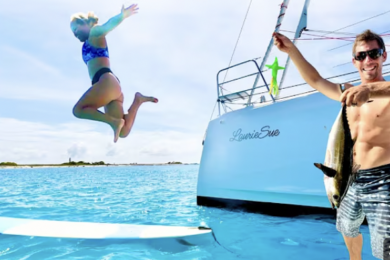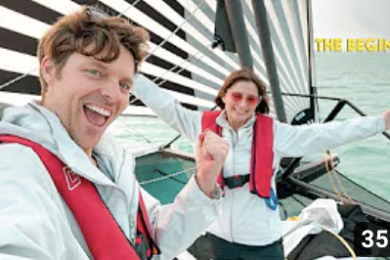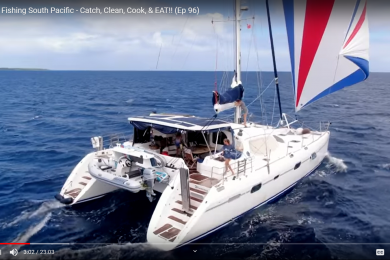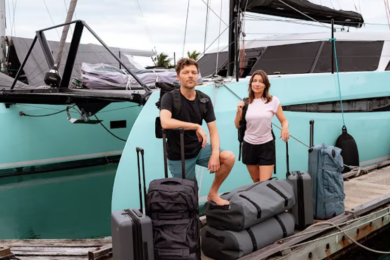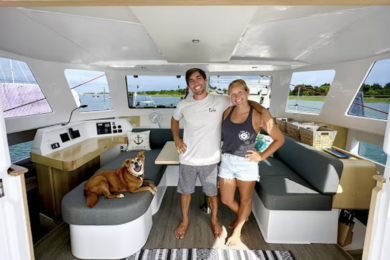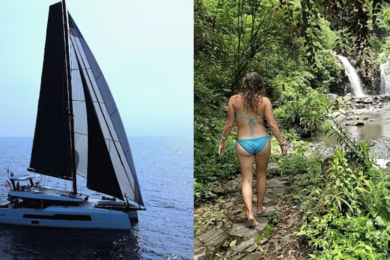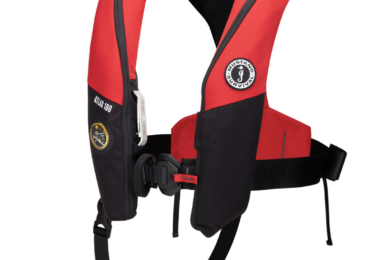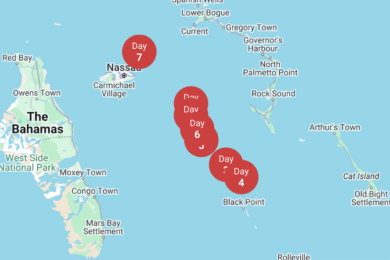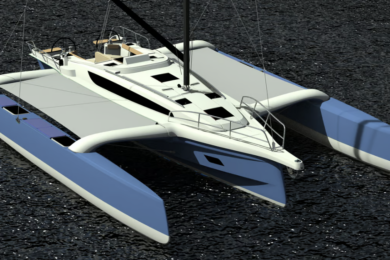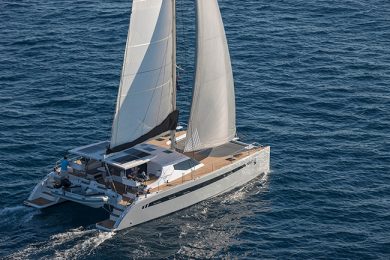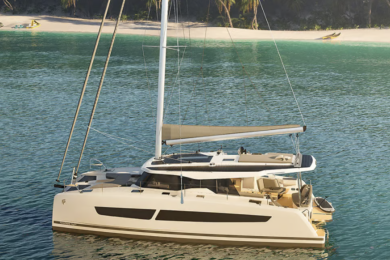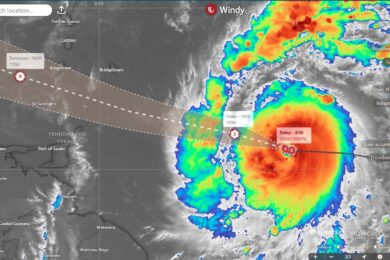In early January 2004, I was waiting in the Beagle Channel for a good weather forecast. It is 525 miles across the notorious Drake Passage and I wanted to start in reasonable conditions, not least because I was sailing singlehanded. On January 22nd, the five-day forecast looked good, so I set sail for Elephant Island at the eastern end of the South Shetlands. When we crossed the Antarctic convergence, the seawater temperature dropped to a little above 32º F, and it was time to light the Dickenson diesel range. That evening, we crossed 60 south, the official Antarctic border, and the next day I spotted the first iceberg. Visibility was down to a mile and it was blowing about 22 knots from the west, but then eased.
As it cleared, I sighted Elephant Island. I headed for Emma Cove, on the east coast, pleased to have had such a painless crossing. Emma Cove is surrounded by black scree cliffs and was a rather forbidding place in the sleet that had started to fall. The next morning, I managed to get ashore, but with the swell it was not easy. This was no place for a swim.
POINT WILD TO GIBBS ISLAND
My ambition was to sail China Moon—a 38-foot, open bridgedeck catamaran of my own design, constructed of plywood with an unusual side-by-side, cambered panel junk rig—to the Antarctic. As I sailed along the north shore with the wind picking up, there were patches of thick fog and many icebergs and growlers to avoid. The fog cleared as I went past Point Wild (where the Endurance survivors waited for Shackleton). I had hoped to anchor there, but it was too windy, so I carried on past Cape Valentine, where the wind switched off as we sailed into the lee of the island.
I sailed overnight down to Cape Lookout at the southern end of the island. On the way, the wind blew around 18 knots from ahead, and in the bumpy ride the self-steering trim tab jumped off the rudder and was lost—a bit of a calamity. I hove-to for three hours in the dark and got a little sleep. In the morning, I motored in and anchored just north of Cape Lookout off a small glacier. It was a beautiful sunny morning and Clarence Island was clearly visible to the east.

The next morning, I anchored in the cove at Cape Lookout. What a wonderful place it was, with a large chinstrap penguin colony as well as elephant and fur seals. It would have been nice to spend the day there, but the wind picked up from the east, blowing straight in. I headed down to Gibbs Island and discovered a beautiful little bay on the south side where, on a grounded bergy bit, two leopard seals were sleeping off their penguin lunch. By the time I had been ashore I was tempted to stay the night, but there was too much ice close inshore and I was afraid I might get trapped.
KING GEORGE TO HALF MOON ISLAND
I set off for King George Island and connected the windvane directly to the tillers, which worked well enough. So well, in fact, that I continued with this for the rest of the voyage. I carried on sailing overnight, reefed right down, keeping a constant lookout from the Perspex dome. The next morning, I anchored at Penguin Island, a small island close to the south coast of King George, and later sailed across King George Bay to a likely looking anchorage. I had hardly gotten the anchor down when strong gusts started coming off the cliffs, and it seemed prudent to find better shelter. It was now about 1700 and the nearest place was Admiralty Sound, but it was filled with ice, so I carried on to Potter Cove at the west end of the island. After a very hard beat, I eventually got the anchor down at 2330, in the last of the light.

Poor weather kept me there for several days, but I managed to get ashore and had the luxury of a hot shower at the Argentine base. When the weather cleared, I sailed to Robert Island, anchoring at Coppermine Cove. Ashore, there was a small Chilean base and the five members came down to the beach to welcome me. They had been coming each summer for several years, but this was the first time a yacht had called.

The next morning, the barometer had fallen again so I moved seven miles over to Iquique Cove on the north side of Greenwich Island, where there is a Chilean naval base. The entrance is a very narrow, with several rocky shoals to avoid, but opens out into a very sheltered harbor. As I came around the corner, there was a welcoming committee waiting on the jetty and they waved me over to pick up a buoy. On going ashore, I was ushered straight into the building, given a cup of coffee and settled in front of the satellite TV to watch Manchester United play Everton at soccer.
In the evening, we went by Zodiac to the nearby Ecuadorian base. Their HF radio was broken and Max, the electronics wizard, fixed it. They were delighted, and an impromptu party started with the wine flowing freely. As we left, I was given a large care package of goodies. What nice people. The ride back was very exciting in the dark, dodging ice at high speed. It blew a gale the next day, but I got away on Monday, February 5th, sailing to Half Moon Island. As I anchored, two people came down from the Argentine naval base. It was too windy to get ashore then, but I went later when the wind dropped.
LIVINGSTON ISLAND TO (ALMOST) THE SOUTH ORKNEYS
The next morning was fine and sunny as I slowly tacked out of the bay in a light wind, but when I got around the corner of Livingston Island, the wind picked up to 22 knots and I beat into rough seas to Deception Island. I arrived the next morning, with the wind stronger and gusting. I thought Neptune’s Bellows—the entrance to the crater—might live up to its name and anchored in the lee of the island, by Bailey Head. The next day, I entered the crater, anchoring in Whalers Bay by the remains of the British Antarctic Survey base and the old whaling station.
I felt that I would be pushing my luck to go further south as there would be much more ice and the nights were getting longer, so it seemed prudent to call a halt. The holding in Whalers Bay is reported to be poor, so rather than worry about dragging, I decided to make use of the southwest wind and set off after supper. I had a quick run overnight with enough light from the moon to carry on to Maxwell Bay, King George Island. I left the next morning, Valentine’s Day, for the South Orkneys.
That night, I had to stop for about five hours of darkness. I dropped the sails and lay ahull, waking every half hour to make sure I had not drifted close to any ice. The next evening, the ice was getting thicker and I stopped near a large tabular berg overnight. In the morning, there was mist and hail showers and I was hand steering to dodge the increasing ice. By lunchtime, visibility had improved but there was a continuous line of white ahead. I retraced my steps until I could turn east again, and at 2130, lay ahull after 18 hours at the helm.
At 0330 there was enough light to get going again, but little wind. Soon, I was motoring. The ice got progressively thicker until I had to weave around the bergs. I now realized that I was at the edge of the pack ice—very unusual for it to be so far north in February. I was only 55 miles from the South Orkneys, but already north of them. It was time to give up. I bore away for South Georgia and spent the rest of the day with the pack in sight to the east. In the evening, the wind picked up to around 22 knots from the southwest. We were doing 7 to 10 knots, and for half an hour two 60-foot fin whales kept me company, blowing close alongside.

SOUTH GEORGIA TO GRAINGER BAY
It took another five days to get to South Georgia. As I went northeast, the ice thinned out, but the day before I arrived it started increasing again. When I got to the 100-fathom line, there was lots of ice about. Two enormous bergs were aground south of the island. Together, they were larger than South Georgia (which is 120 miles long) and they were producing all this ice. Once through Stewart Strait, the ice thinned out and I anchored in Elsehull, where the air was full of yellow-nosed albatross.

I sailed down to King Edward Cove, where I spent a week, leaving on the 1st of March. I had hoped the ice would just be close to the island, but it went on and on and I had to stop for the first three nights. Then the weather changed and for the next week it was very rough. Much of the wind was 25-ish knots from the northwest, so I was close hauled to get north. By then, the ice was left behind and I could turn off the diesel range. After two weeks at sea—and on my 54th birthday—I arrived at the Tristan de Cunha group.
I anchored overnight at Inaccessible Island, where steep, grass-covered cliffs surround a flat plateau on top. The island is well named, and with the exception of a hut ashore, very wild. I had a walk ashore the next morning, and in the afternoon sailed over to Tristan, 25 miles away, where I anchored off the village of Edinburgh. With a population of 275, Tristan is the most remote community on earth—2000 miles from its nearest neighbors. The area they live on is tiny; the village has a few fields behind it and “potato patches” a mile or so away, but the rest is sheer cliffs straight up to the plateau.

After two days, I set off for Gough Island. As I was approaching it, the barometer started to fall and the wind and rain filled in from the northwest. It was blowing about 30 knots and I did not fancy trying to find dubious shelter in these conditions, so I carried on. The rest of the trip was uneventful; the worst weather was at the end with a gale force black southeaster blowing as I approached the Cape. It died out as the day progressed and I ended up motoring in a flat calm for the last few miles to anchor just before sunset on March 31st in Cape Town’s Grainger Bay.
Pete Hill started sailing as a teenager in the 60s, and in 1972 helped deliver an OSTAR entry back from Newport to Cannes, France. He has spent much of the last 40 years voyaging in self-built junk-rigged boats, from the Arctic to Antarctic. In 2006, Pete entered the inaugural Jester Challenge singlehanded transatlantic ‘race’ and was one of only two finishers. More recently, Pete has been cruising with his partner, Carly Du Preez, in the South Atlantic and is now building a 33-foot junk-rigged catamaran in Cornwall, England.


